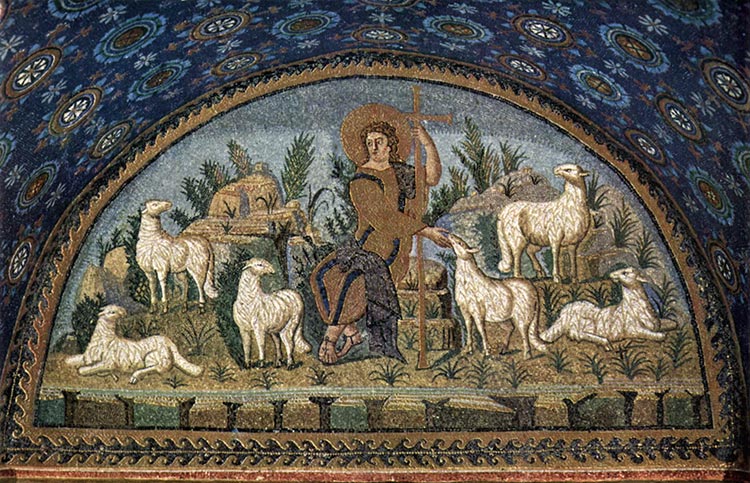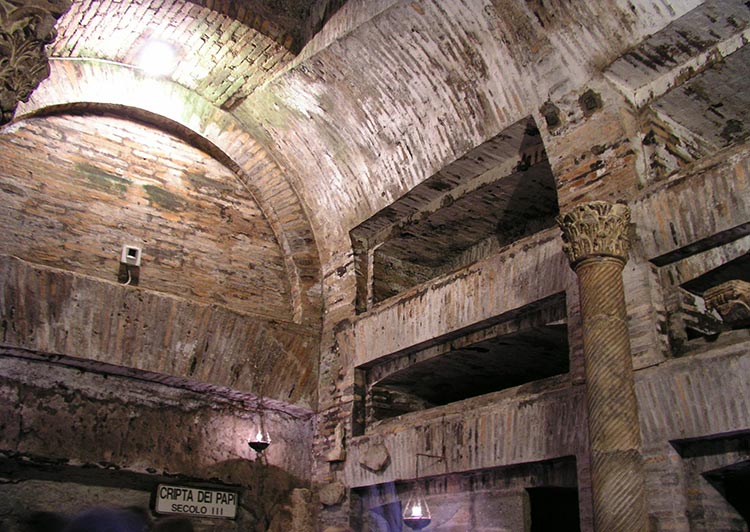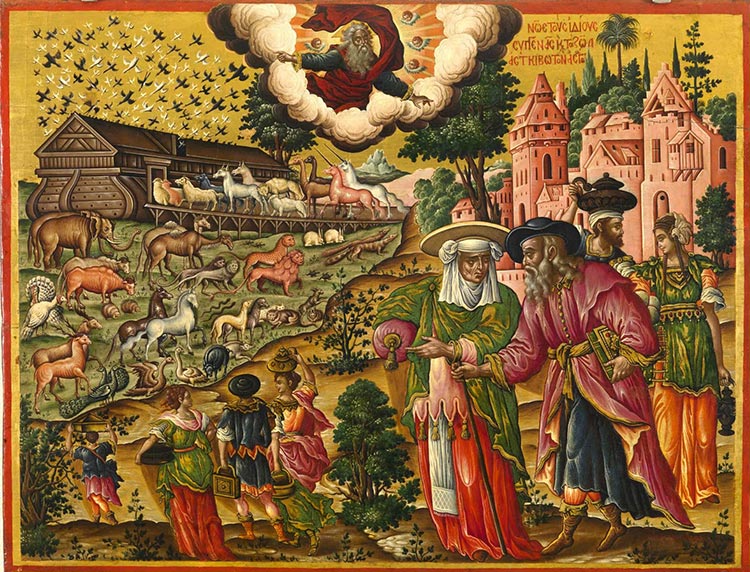
Christian Philosophy & Culture
The Christian Church: The Symbolism (Part 1 of 4)
What exactly is the meaning of symbolism? The indirect expression by means of an image of something which no form, visual or verbal, can convey directly, for all means are inadequate and powerless in face of the truth which they must try to express. Symbolism, the language of mystery, reveals the truth to those who know how to interpret it, while concealing it from the uninitiated.
Colloquial speech confuses the meanings of "sign" and "symbol". Spiritually, it is advisable to distinguish them. The sign limits itself to indicating a particular fact; the symbol expresses and somehow incorporates and makes present a higher reality. To understand a symbol is to experience a presence; to understand a sign is to translate a piece of information. Let us take the cross as an example. In arithmetic it is simply a sign which denotes addition. In the Highway Code it indicates cross-roads. But in religion it is a symbol which expresses and communicates the inexhaustible content of the Christian faith.
Symbolism plays a very important role in the Church, because everything in the Church has, so to speak, a dual character: material and spiritual. The material is directly accessible to our senses; the spiritual is suggested to us through symbols. One cannot fruitfully study the symbolism of the Church apart from the Liturgy: the two developed together, and the Fathers explained symbolism in terms of the Liturgy. Cut off from the divine service symbolism loses its meaning and becomes a series of sterile abstractions.
The word "church" (in Greek ἐκκλησία ) means "convocation", "reunion". The Church "is so named because she calls all men together and unites them each to all", says St. Cyril of Jerusalem (1).
 Above: The Good Shepherd, from The Mausoleum of Galla Placidia, Ravenna, Italy
Above: The Good Shepherd, from The Mausoleum of Galla Placidia, Ravenna, Italy
The verb " καλῶ " means "to call"; " ἐκκαλέω " means "'to convoke", to call forth. Those who are thus called forth are the apostles and the disciples of Christ, the New Israel. In the Old Testament the people of Israel were set apart, separated from the world, in order that they might make known to the world the divine incarnation, and prepare the way for the coming of the Messiah. As the New Israel, the Church in her turn brings to the fallen world the presence and the promise of the Kingdom of God . She prepares this world for the Second Coming.
The word "church" means both the Body of Christ, His Kingdom, constituted by the community of all the faithful, and the place of worship. In our prayers at the consecration of churches the place of worship is actually called a "house in the likeness of heaven", an "image of the dwelling place of God". It is consecrated "in the image of the most holy Church of God, that is, of our very body which Thou has deigned to call Thy temple (and members of Thy Christ) through the mouth of Thy glorious Apostle Paul", that is to say, in the image of the Church which is, according to St. Paul, the Body of Christ (Ephesians i, 23 and Colossians i, 18). Thus a church is an image, an icon, of the Church, the Body of Christ. In other words, a church is an image which expresses symbolically what cannot be expressed directly, since there exists neither language nor imagery to describe directly the one, holy, catholic and apostolic Church, which is an object of our faith, yet invisible in her plenitude.
The foundation of the Christian life is always the same, whether in the first centuries of our era or today. It is a birth into a new life, an intimate union with God which is essentially realized in the sacrament of the Eucharist. Our churches, as the places where this sacrament is performed and where the people, thereby united and renewed, assemble, are different from all other places and buildings. They bear the impression of that which takes place in them. It is characteristic that among the many names which the early Christians gave to the temple, such as "the church" or "the house of the Church", the one most widely used was "the house of the Lord" (2) . This name in itself underlines the difference between a church and any other building, and expresses its specifically Christian significance.
This significance is connected with the heritage of the Old Testament. The Tabernacle of the Old Testament, which prefigures the churches of the New Testament, was constructed according to the plan revealed to Moses on Mount Sinai . God Himself directs not only the general plan, but the whole arrangement, down to the smallest details. The history of the Church shows that the first Christians did not break with the past; on the contrary, they considered themselves the direct heirs of the Old Testament. The Christians were the New Israel, the fulfillment of the prophecies. The apostles and the Fathers constantly emphasize the traditional character of the new faith. The apostles and the early Christians in general went to the synagogues and to the Temple of Jerusalem, and took part in the Jewish life of worship. Only when they were refused admission did they build specifically Christian sanctuaries, and even then they were careful to preserve the revealed pattern of the place of worship, the principle in accordance with which the Tabernacle and the Temple of Jerusalem had been built. They brought out the real meaning of this principle, the meaning of the New Testament and the fulfillment of the prophecies. Therefore it seems beyond dispute that the essential significance of a church, which is so closely linked with the very essence of Christianity, was understood by all believers in the first centuries of our era, even though it was not at once explicitly formulated in theoretical terms.
 Above: The erection of the Tabernacle and the Sacred vessels, from the 1728 Figures de la Bible
Above: The erection of the Tabernacle and the Sacred vessels, from the 1728 Figures de la Bible
We know from historical and archaeological researches that the Christians of the first few centuries did not have only the catacombs and the places for prayer in private houses referred to in the Acts of the Apostles and in the Epistles (3), but that they also built churches above ground (4). During times of persecution these churches were destroyed and later rebuilt. But, in spite of the existence of these churches, neither the early Fathers nor writers in general have much to say about the Liturgy, and they say nothing at all about the meaning of the church, its significance, and its symbolism. Why this silence ? It is thought to be due to two reasons: firstly, there was absolutely no need to write down something which was common knowledge, by which indeed all lived; secondly, the early Christians had no intention of initiating into their sacraments the pagans amongst whom they lived, of revealing to them their faith and their hope. The truths of the faith were confessed above all in life itself, and were rarely formulated. That is why the symbolism of the Church, like the dogmatic truths of the Christian faith, was not systematically expounded during this period.
 Above: The catacomb of Callixtus, Rome, Italy
Above: The catacomb of Callixtus, Rome, Italy
Nevertheless we have some evidence from the first few centuries of how Christians conceived of the place of worship. Thus, in the Didache it is said that a church should remind the faithful of a ship, and should have three doors to evoke the Holy Trinity. We know that the Fathers very often use the image of the ship, and in particular the Ark of Noah, to symbolize the Church. Noah's Ark was a prefiguration of the Church; just as this ark served as a refuge at the time of the flood, the Church, guided by the Holy Spirit on the waters of life, is the safe refuge of Christians. That is why it was usual to apply this image to the church, the place of worship. Even today we call the middle part of our churches the nave. On ancient monuments we find symbolic images of Noah's Ark in the form of square chests, sometimes with a dove on top. Archaeological excavations have shown that a great many churches of the early centuries were built exactly to a square plan, that is, in the image of the Ark. At first sight, to an outsider, this analogy might seem abstract, artificial, void of deep meaning, as also the use of three doors to indicate the Holy Trinity. But in reality this is not the case. If we remember that the small Christian communities were surrounded on all sides by a more or less hostile paganism and that they were subject to periodical persecutions, we shall realize that the church was for them truly an ark, where they found salvation in the sacraments.
 Above: Noah's Ark, 17th century, Museo Dipinti Sacri Bizantini, Venice, Italy
Above: Noah's Ark, 17th century, Museo Dipinti Sacri Bizantini, Venice, Italy
As far as the symbolism of the three doors is concerned, this image also was neither abstract nor lacking in significance. The doctrine of the Holy Trinity is not only a teaching of the Church about God, one in three Persons; it is the very foundation of the life of the whole Christian community. In fact, the Holy Trinity is the prototype of that love which still today sustains every Christian community, be it a monastery, a parish or any other organism. The very life of this community is love, without which it cannot be realized. This is the reason why, down to the present time, everything in our churches reminds us of the Trinity: the three parts of the church, the three fingers with which we cross ourselves, and so on.
These examples show that in the primitive churches, just as in ours today, everything had a symbolic meaning, everything was designed to lift up the soul and spirit of man to the divine life. In other words, the very architecture of the churches lifts us up to contemplate realities which are not only invisible but which also cannot be expressed directly. The objects that our bodily eyes behold thus become symbols which introduce us to the divine world. This is an application of the patristic formula: visible objects lift us up to the contemplation of invisible things.
From the fourth century onwards, symbolism in the church begins to be explained and commented on in greater detail. Two circumstances, above all, made such explanations necessary: firstly, under St. Constantine the Church was given the right legally to exist in the Roman Empire . This most important historical event led to the triumph of the Church, and had very important consequences for her art. The construction and embellishment of churches developed a richness hitherto unknown. The well-known Church historian, Eusebius, Bishop of Caesarea, speaks at length and with great enthusiasm about these buildings. A great multitude of new converts filled the new churches. The majority needed explanations about the Christian faith and needed spiritual guidance. One of the means by which this instruction was given was the symbolism of the churches and of Christian worship. This necessity to explain the meaning of the churches could not but influence the theoretical exposition of symbolism; it made it essential.
The second circumstance was that, from the fourth century onwards, Christian worship took on clear and precise forms. Our Liturgies, which bear the names of St. John Chrysostom and Basil the Great, date back to that period. The rapid progress in the perfecting of rites and the decoration of churches is described by Eusebius, writing in the reign of Constantine : "A clear, bright day, without hint of cloud, illuminates with rays of a divine light the churches of Christ throughout the universe. . . . Churches are rebuilt from the ground up to a great height and are much more beautiful than the old, destroyed churches. . . . Feasts for the renovation or the consecration of these new churches began to be celebrated in the towns. . . . The services and holy rites which the priests celebrated became more perfect, acts of worship more beautiful (5).
Some ancient liturgies (for example the Syriac text of the Liturgy of St. James) contained commentaries for the instruction and direction of the faithful. These commentaries were embodied in the actual text of the Liturgy, and were read by the deacon in the course of the celebration. It is thought that these commentaries were incorporated into the text at the end of the third or beginning of the fourth century, that is to say, at a time when they were particularly necessary owing to the tremendous number of converts pouring into the Church. This leads us to wonder whether in our own time also such commentaries might not be useful, at least after the Liturgy, during the sermon. It is true that the majority of us are not recent converts; nevertheless, our understanding of these things is somewhat vague.


